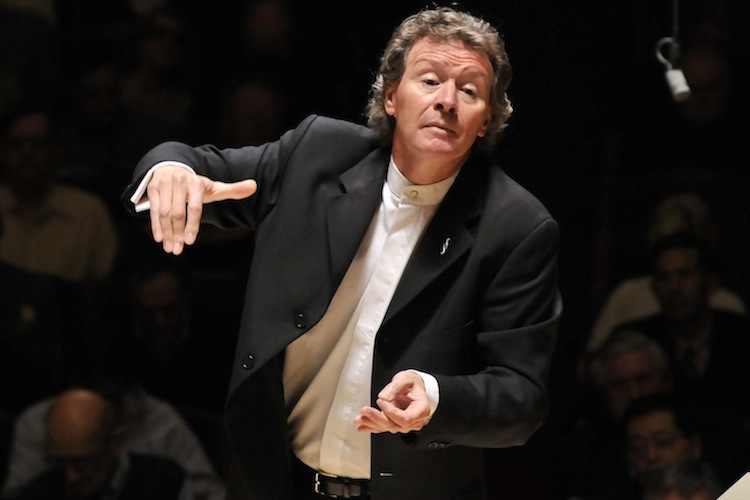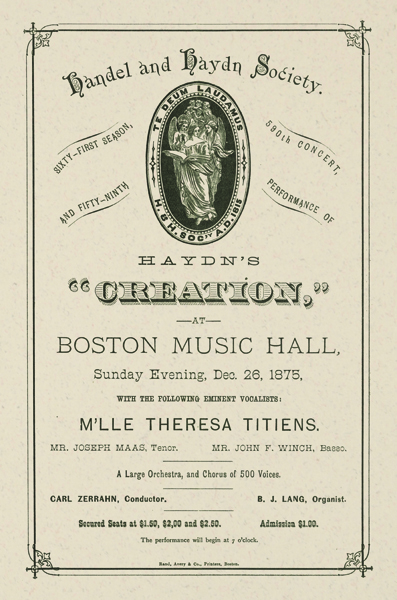After 200 years, the Handel and Haydn Society is still looking for new challenges
In 1815, a Boston musical society was formed to cultivate, through performances, the works of Europe’s greatest composers, living and dead. The mission of the organization was clear from its name. Handel was to represent the “old,” Haydn the “new.”
Today, the Handel and Haydn Society, which celebrates its bicentennial this season, is internationally recognized for its historically informed performances and sweeping concert programming.
“It’s still the longest performing arts organization in America, and that’s quite something,” said Harry Christophers, conductor and artistic director of H&H. “There are actually few arts organizations throughout the world that have sustained that kind of history.”
It’s a history that is marked by many firsts as H&H has brought some of Europe’s most endearing sacred choral works to American soil. The society gave the first American performance of the complete Messiah in Christmas of 1818, and followed with Haydn’s The Creation in February 1819. Maintaining its mission of presenting the old as well as the new, H&H offered the U.S. premieres of Verdi’s Requiem in 1878 and Bach’s St. Matthew Passion in 1879.
Given this rich history, Christophers has the luxury of looking back over two centuries of performances to take a second look at the works H&H hasn’t touched in well over a century. Little-performed Handel oratorios are a particular favorite for the conductor. The last two seasons alone featured updated performances of Samson and Jephtha.
“I think programming needs to occasionally challenge the audience with something they don’t know and they are unfamiliar with,” he said. “The public don’t need to be thrown sort of popular classical music at it as an item to ensure that they come to things.”
“There are a lot of wonderful Baroque and Classical composers that we don’t perform that much of, and also the great composers where we haven’t in the past necessarily performed many of their less well-known works,” he added.
The bicentennial season will offer highlights from the society’s rich performance heritage through a bracing mix of little-known and well-known music.
H&H will open this week with a program of greatest hits. Billed as “Baroque Fireworks,” the concert will feature a selection of popular Handel anthems, including Zadok the Priest, the composer’s Music for the Royal Fireworks, Vivaldi’s “Summer” from The Four Seasons, and Bach’s motet Singet dem Herrn.
Later this month, H&H concertmaster Aisslinn Nosky will lead the period instrument orchestra in Vivaldi’s L’estro armonico concertos along with a Torelli Concerto Grosso and Tartini’s fiendishly difficult Devil’s Trill Sonata. The annual Christmas program, to be led by Scott Allen Jarrett, will feature Bach’s Cantata IV from the Christmas Oratorio and the cantata Dazu ist erscheinen der Sohn Gottes alongside Corelli’s Christmas Concerto and works by Schütz, Vulpius, and Sweelinck. Nosky will appear as soloist in January for Haydn’s Violin Concerto in C Major as part of an all-Haydn program, and Richard Egarr will return in February to conduct H&H in Mozart’s Waisenhaus Mass and Beethoven’s Symphony No.1
The spring will bring a host of choral works. In March, former director Grant Llewellyn, standing in for Christopher Hogwood who passed away two weeks ago, will H&H in Mendelssohn’s Elijah. Christophers will revive Bach’s St. Matthew Passion later that month and will close with Haydn’s The Creation in May.
The H&H bicentennial will stretch into next season, and will feature more works on the classical side of the society’s repertoire, such as Mozart’s Requiem as well as pieces that appeared on H&H’s very first program in 1815.
“It’s nice digging up those sorts of things, and actually relishing in the legacy that H&H has given us,” Christophers said.
No season, though, would be complete without Handel’s Messiah, which H&H performs each November.
“Messiah is a phenomenal tradition. This will probably be the one hundred and sixty first successive year that they’ve done it,” the conductor said. “But we don’t allow [the audience] to sit on their seats and sit back and just go through the motions. We present them a real drama, and entertainment is what Messiah should be.”

Harry Christophers will open the Handel and Haydn Society’s 200th season Friday night at Symphony Hall. Photo: Stu Rosner
In its bicentennial year, H&H finds itself in a strong financial situation. Since Marie-Hélène Bernard took over as executive director in 2007, the society has increased its annual fund and grown its endowment and assets. H&H ended the 2014 fiscal year with a surplus of $11,312, and the society currently operates with budget of about $5 million and an endowment of over $6 million.
“It’s really looking at how we promote H&H and how we position the organization and our entire advertising self-strategy combined with how we cultivate and steward our donors and how we basically seek support from the community,” said Bernard of H&H’s financial strategy.
One of the ways that H&H gives back to the community beyond its performances is through its educational initiative. Through an endowment from Karen and George Levy, the Handel and Haydn Society manages music education programs for about ten thousand children in the greater Boston area each year. Its Vocal Arts Program provides choral training and performance opportunities for children in grades 3 through 12. H&H musicians also visit local schools to give recitals and presentations throughout the year.
“You have to keep in mind that ninety percent of our education programs, which are pretty extensive, are subsidized, meaning that H&H is raising money to make them happen,” Bernard said. “So the ten thousand children that get some form of music education from H&H get it free at no cost.”
One thing that Christophers has done is provide the Vocal Arts Program’s young men’s and young women’s choruses the chance to perform along with the H&H choir and period instrument orchestra in a large choral work. This year, that work will be Bach’s St. Matthew Passion, which Christophers plans to offer biennially beyond this season.
“The more we do that work the more we’ll get right into the character of Bach and get better and better at it. We’re already pretty good at it, [but] you can never sit back on your laurels,” he said.
In addition, Christophers will continue H&H’s popular survey of Haydn symphonies and concertos in future seasons. It’s a project he hopes will challenge some of the entrenched notions regarding the composer and his music.
“So many people are very often people who regard Haydn as the sort of grandfather of the symphony, and in that sense by many he’s regarded as a bit of old fuddy-duddy,” Christophers said. “But actually he is one of the wittiest, one of the most emotional composers you can come across.”
“[Playing Haydn] has been really important, and actually has, I think, had a major impact on the stylish way in which the orchestra plays,” he added. “I mean, they have come on remarkably through this project, and just realizing the amount of character that can come out of this music. . . That’s one of the things I strive for in performance of both instrumentalists and singers is that they release their personality to the audience. And we see some of that rather than being a sort of robot that the conductor tells [the performers] exactly what they need to do. I wish for a lot of license in the playing.”
That license is built upon the Society’s strong professional foundation, the current model of which has been in place for nearly fifty years. In 1967, director Thomas Dunn transformed the chorus into a small elite ensemble. And the late Christopher Hogwood, who came to the Society in 1986, began the now-standard practice of using period instruments in the orchestra. Hogwood also expanded the ensemble’s reputation through recordings and tours, and spearheaded creative projects with other art forms, including dance and jazz.
“Chris was somebody who actually changed, really just changed, indeed, the mission statement of the whole organization,” said Christophers. “By turning it into the orchestra into a period orchestra actually what we do is make the old music sound new.”
“I think that when the early music movement started, whichever country got going with it, each country found that they were learning in the job,” he added. “Now we’re at a stage where people are coming through who are so adept at their playing, and have so much knowledge about all the treatises written at the time, that we can sort of pull loads and loads of ideas.”
The historically informed approach can sometimes yield stuffy performances from period ensembles, but Christophers doesn’t see that as problem for H&H. “There has been some rigidity of being bound by academia,” he said, “[but] we don’t necessarily go by the book. Ultimately what we’re aiming for is very stylish, very musical playing that is full of interpretation, from Monteverdi through Handel, Bach, to Haydn and Mozart.”
“Ultimately the music must come alive, and that is what we’re striving to do,” he said. “There are no bookworms in H&H.”
Harry Christophers and the Handel and Haydn Society will kick off the bicentennial season with “Baroque Fireworks,” featuring music by Bach, Handel, Vivaldi, and Stevenson 7:30 p.m. Friday and 2 p.m. Sunday at Symphony Hall. handelandhaydn.org; 617-266-3605.
Posted in Articles




